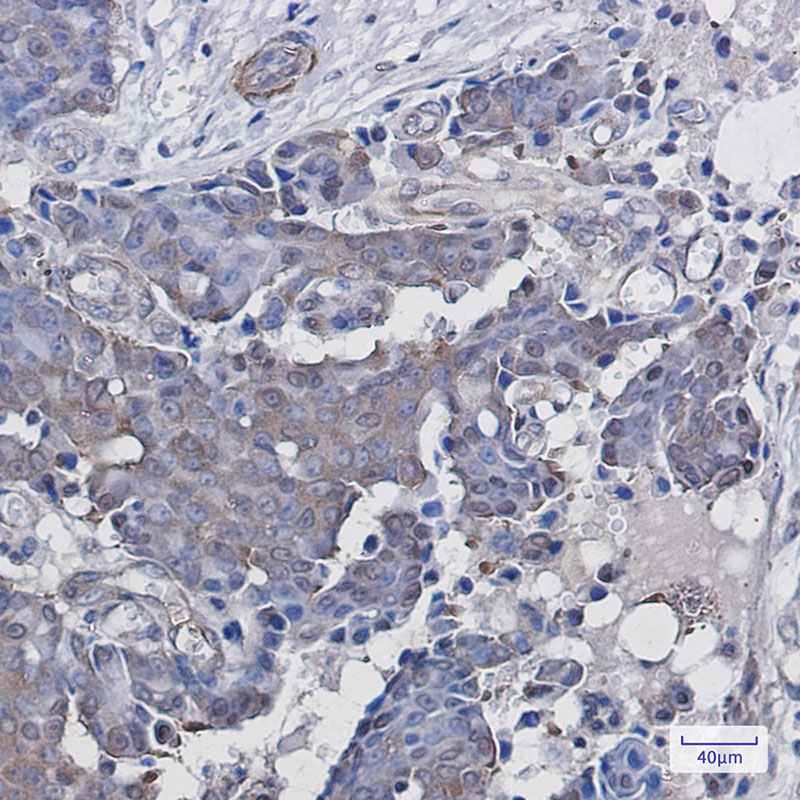


| WB | 咨询技术 | Human,Mouse,Rat |
| IF | 1/20 | Human,Mouse,Rat |
| IHC | 1/50-1/100 | Human,Mouse,Rat |
| ICC | 1/50-1/200 | Human,Mouse,Rat |
| FCM | 咨询技术 | Human,Mouse,Rat |
| Elisa | 咨询技术 | Human,Mouse,Rat |
| Aliases | ARM1; ARM-1; GP110 |
| Entrez GeneID | 11047 |
| WB Predicted band size | Calculated MW: 42 kDa; Observed MW: 42 kDa |
| Host/Isotype | Rabbit IgG |
| Antibody Type | Primary antibody |
| Storage | Store at 4°C short term. Aliquot and store at -20°C long term. Avoid freeze/thaw cycles. |
| Species Reactivity | Human |
| Immunogen | A synthetic peptide of human ADRM1 |
| Formulation | Purified antibody in TBS with 0.05% sodium azide,0.05%BSA and 50% glycerol. |
+ +
以下是关于ADRM1抗体的3篇参考文献的简要整理(文献信息为示例性概括,具体引用时请核实原文):
---
1. **文献名称**:*ADRM1 as a therapeutic target in cancer: Insights into its functional role and antibody development*
**作者**:Zhang Y, et al.
**摘要**:研究揭示了ADRM1在多种肿瘤中的高表达,并证明其通过调控蛋白酶体活性促进癌细胞增殖。文章开发了一种特异性ADRM1抗体,体外实验显示其能抑制肿瘤生长,提示其作为潜在靶向治疗工具的价值。
2. **文献名称**:*ADRM1/RPN13 antibody-based detection in hepatocellular carcinoma progression*
**作者**:Huang L, et al.
**摘要**:通过免疫组化分析肝细胞癌样本,发现ADRM1表达与患者预后不良相关。研究利用ADRM1抗体验证其与Wnt/β-catenin通路的相互作用,提出ADRM1可能作为肝癌诊断的生物标志物。
3. **文献名称**:*Structural characterization of ADRM1 and its application in colorectal cancer*
**作者**:Xu J, et al.
**摘要**:文章解析了ADRM1蛋白的抗原表位,并基于此制备多克隆抗体。实验表明,该抗体可阻断ADRM1与泛素链的结合,抑制结直肠癌细胞迁移,为开发基于ADRM1抑制剂的疗法提供依据。
---
如需进一步获取具体文献的DOI或发表年份,建议在PubMed、Web of Science等平台检索关键词“ADRM1 antibody”或“RPN13 antibody”。
The ADRM1 (Adhesion Regulating Molecule 1) antibody is a tool used to detect and study the ADRM1 protein, also known as RPN13. a key component of the ubiquitin-proteasome system (UPS). ADRM1 functions as a receptor in the 26S proteasome, facilitating the recognition and degradation of ubiquitinated substrates, thereby regulating protein homeostasis. Its structure includes an N-terminal Pru domain for proteasome binding and a C-terminal region with tandem ubiquitin-binding sites, enabling interactions with polyubiquitin chains.
ADRM1 has garnered attention in cancer research due to its overexpression in various malignancies, including ovarian cancer, multiple myeloma, and hepatocellular carcinoma. Elevated ADRM1 levels correlate with tumor progression, poor prognosis, and chemoresistance, likely by enhancing proteasome activity to evade apoptosis. This makes ADRM1 a potential therapeutic target, with research focusing on inhibitors to disrupt its function.
Antibodies against ADRM1 are essential for techniques like Western blotting, immunohistochemistry, and immunofluorescence to quantify protein expression, assess localization, and validate target engagement in experimental models. They also aid in studying ADRM1's role in diseases beyond cancer, such as neurodegenerative disorders linked to UPS dysregulation. Recent studies explore ADRM1's involvement in immune signaling and DNA repair, broadening its biomedical relevance. Despite promising preclinical data, clinical applications remain exploratory, emphasizing the need for further investigation into ADRM1's mechanistic pathways and therapeutic potential.
×